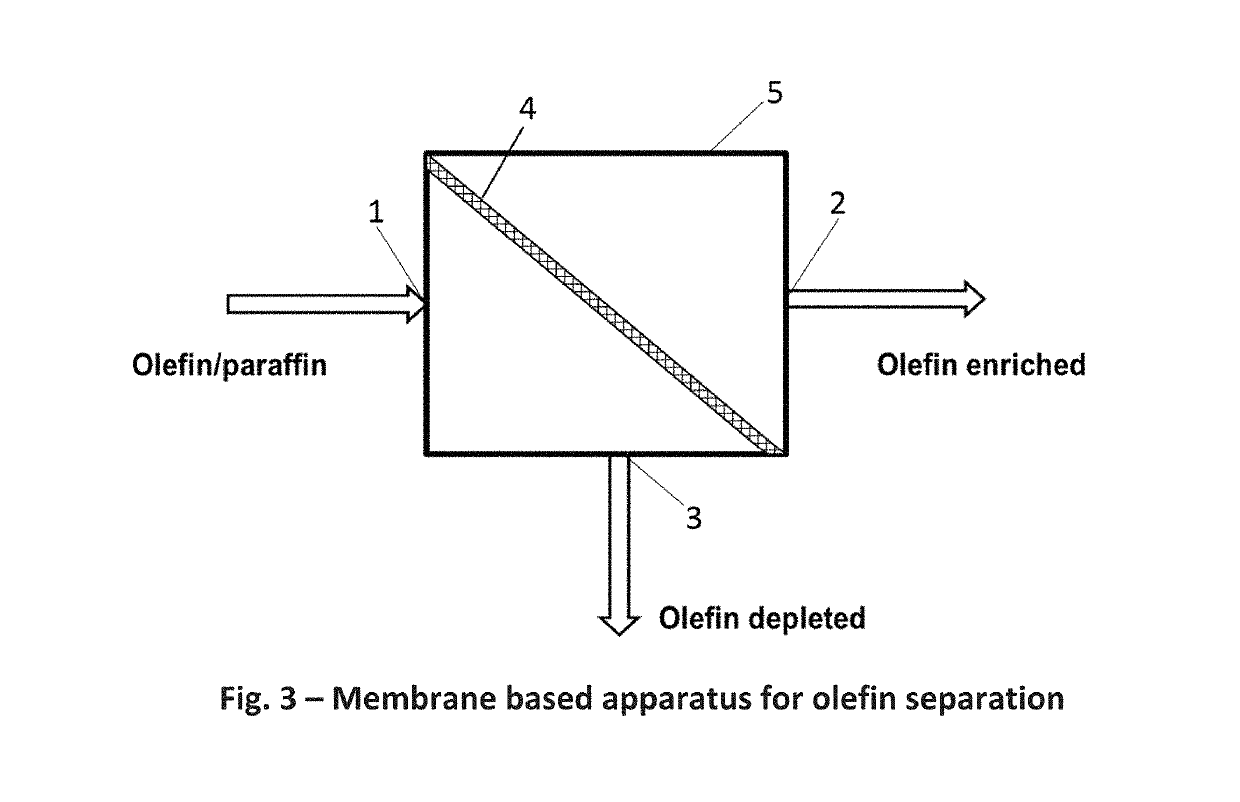Mixed matrix membranes for olefin/paraffin separation and method of making thereof
a technology of olefin/paraffin and mixed matrix membrane, which is applied in the direction of membranes, dispersed particle separation, separation processes, etc., can solve the problems of little work done on propylene and propane separation, unstable, etc., and achieves low production cost, poor reproducibility, and loss of mechanical strength of polymeric membranes.
- Summary
- Abstract
- Description
- Claims
- Application Information
AI Technical Summary
Benefits of technology
Problems solved by technology
Method used
Image
Examples
example ii
lite Nano-Powders and Zeolite Metal Doping
[0026]This example shows the preparation procedure of ETS-10 nano-powders and the zeolite metal doping process. The ETS-10 molecular sieve synthesis is shown here. 1.3 g potassium chloride, 6.9 g sodium chloride, and 1.5 g potassium fluoride were dissolved into 20.0 g distilled water. 20.0 g sodium silicate solution was added into the above-mentioned solution, while stirring at room temperature for at least 2 hours until a homogeneous solution was formed. This solution was then mixed with a titanium source (1.3 g, anatase P-25) and diluted with another 40 ml DI water under stirring at room temperature for 3-4 hr. The precursor was transferred into a Teflon® cup fitted into an autoclave. The autoclave was placed in an oven for hydrothermal synthesis at 210° C. for 24 h. The synthesized slurry was washed with the distilled water three times to obtain the nano-particles.
[0027]Ion-exchange process was conducted over the powders by using silver n...
example iii
#MMM-6 Membrane Preparation and Separation Performance
[0028]These examples show the preparation procedure for MMM membranes with polyamide-imide (PAI) as the polymer matrix, and metal-doped Y zeolite powders, as well as their separation performance. Molecular sieve (Y-type) nano-particles were dispersed into organic solvent (NMP) and stirred for 3 h to have an even dispersion of the particles. Then 33% (wt) of the total amount of polymer was first added to the solution and stirred for 5 h to prevent the aggregation of molecular sieve particles. The remaining polymer (67% wt) was added and stirred for another 24 h to enhance the homogeneity. The solution was then mixed using a high speed mixer and degassed twice by ultrasonic means for 10 min each. The degassed solution was cast on glass plate (with an applicator, space of 10 mil, and 15 mil, respectively) and was slowly evaporated in a vacuum (0.1 bar) oven for 48 h. The film was removed by soaking in water. Finally, the membrane fi...
example iv
#MMM-8 Membrane Synthesis and Separation Performance
[0030]These examples show the preparation procedure for MMM membranes with polyimide (PI) as the polymer matrix and metal-doped ETS-10 zeolite powders. The separation performance of these membranes is shown in Table 3 below.
[0031]Molecular sieve (ETS-10) nano-particles were dispersed into organic solvent (NMP) and stirred for 3 h to have an even dispersion of the particles. Then 33% (wt) of the total amount of polymer was first added to the solution and stirred for 5 h to prevent the aggregation of molecular sieve particles. The remaining polymer (67% wt) was finally added and stirred for another 24 h to enhance the homogeneity. The solution was then mixed using a high speed mixer and degassed twice by ultrasonic means for 10 min each. The degassed solution was cast on a glass plate (with an applicator, space of 15 mil) and was slowly evaporated in a vacuum (0.1 bar) oven for 48 h. The film was then removed by soaking in water. Fin...
PUM
| Property | Measurement | Unit |
|---|---|---|
| temperature | aaaaa | aaaaa |
| temperature | aaaaa | aaaaa |
| temperature | aaaaa | aaaaa |
Abstract
Description
Claims
Application Information
 Login to View More
Login to View More - R&D
- Intellectual Property
- Life Sciences
- Materials
- Tech Scout
- Unparalleled Data Quality
- Higher Quality Content
- 60% Fewer Hallucinations
Browse by: Latest US Patents, China's latest patents, Technical Efficacy Thesaurus, Application Domain, Technology Topic, Popular Technical Reports.
© 2025 PatSnap. All rights reserved.Legal|Privacy policy|Modern Slavery Act Transparency Statement|Sitemap|About US| Contact US: help@patsnap.com


